June 02, 2009 • General
Well, I’m not sure where to begin with this blog. Coming off of the high from the US Championship, I headed to France 10 days later to continue my streak of solid play. Prior to the event, I just wanted to play some good chess and get my rating back over 2700 if possible. I assumed that a score of 3/4 would be good enough, but as fate would have it, I ended up completely outperforming this expectation. Onto the games…
In the first round, I was paired against GM Christian Bauer with White. Last year when I was playing for Antibes, I played Bauer with White in a very interesting and complicated English. This time around, I decided to play 1.e4 and we entered a complicated variation of the Scandinavian. The game was roughly equal until about move 23-24 when Bauer made several inaccurate moves as he neared time pressure. I grabbed a pawn and thought I was clearly better; however, the position actually remained relatively balanced as Bauer’s knight was better than my bishop. Fortunately, he didn’t find the most accurate variation and I was able to convert the advantage into a win right after time control. Although this game was not spectacular, a win is a win. Overall this was the worst game I played by far.
The French League is interesting in that you will always have an idea of who the top few boards on each team are, but actual lineups are only announced two hours before actual game play. This makes the league very similar to the swisses in the US as players must rely more on their knowledge than pure preparation which takes more time. The second round surprised me as I got a second consecutive white against GM Michal Krasenkow of Poland. The last time I played Krasenkow, (Barcelona, 2007) I played probably the most brilliant sacrifice of my chess career thus far, sacrificing a queen for free leading to a spectacular mating net. This time around, I played the Giuco with White, however, this time around Krasenkow chose to play much more aggressively and sacrificed a pawn right out of the opening. This sacrifice proved to be rather futile as I neutralized all of his potential kingside play and duly converted it into a win.
Coming off these first two games, I approached the situation as needing to play solidly. I did not put too much stock into my two wins as they were both with White and I would have to face two formidable opponents with the Black pieces. I got a bit of a break in the third round when I was Black against GM Robert Fontaine instead of the much stronger Vladislav Tkachiev. Before the game, our team captain Arnaud Hauchard said that Fontaine would play to draw, so I simply needed to play solidly. Although I assumed that Fontaine was probably a little scared of me, I did not expect him to play for a draw from move 1! After the first ten moves in the modern, I achieved clear equality and he started to go wrong pretty much instantly from moves 11-15. After this, it was simply a matter of technique and I was able to convert a relatively straight forward endgame. After this win, I was quite ecstatic as it meant I would have accomplished my goal of returning to the 2700+ level barring a huge collapse in the last game.
Whenever I travel to France, it is rather difficult to get on the time zone, so I attempt to accomplish my studying early in the morning (3-5 AM) and then sleep until about two hours before the round in the afternoon. However, this always catches up with me on the last day when the game is always at 10 or 11 AM. The last round was no exception and I barely got three hours of sleep before my game against GM Hichem Hamdouchi of Morocco with Black. For only the second time in my career, I chose to play the dragdorf as I felt it would be one of the lines which Hamdouchi would not be well prepared for. Hamdouchi started improvising right out of the gate when he chose to play a2-a3 and then a3-a4 on consecutive moves. This led to a small advantage for me which I was later able to convert when he sacrificed an exchange which led to a scramble. Out of the time pressure he got into, I was able to get a winning position once the smoke cleared. This led to a 4th consecutive victory. The team also won a relatively easy match and we became the French champions!
Looking back at the games themselves, I was quite proud of my play in three out of the four games, having played pretty close to perfectly. In the French League, I scored 7.5/8 overall against a 2584 average for a performance rating of 3028. This led to me winning the board two medal on top of everything else. Last year, I won the individual medal for board 1, so the real question is if there is any way that I can slide down to board 3! For now, this result puts me at 2710 which is an all-time high for me. Now, I will take three weeks off before I start studying again in preparation for the World Open and the San Sebastian Round Robin. Hopefully, I can remain in form and I will see everyone then!
May 31, 2009 • General
Hello again everyone! I will recap my French adventures later, but for now just a quick update. In the third and final leg of the French League, I went 4/4 beating GMs Bauer,Krasenkow,Fontaine and Hamdouchi. This great result finally pushed me past 2700 again to 2710. Stay tuned for more blogging once I am back in the US tomorrow.
May 23, 2009 • General
Jaan Ehlvest (2606) – Hikaru Nakamura (2701) US Championship, Saint Louis 9.5.2009
1.Nf3 Nf6 2.c4 e6 3.g3 b6 4.Bg2 Bb7 5.0-0 Be7 6.b3 0-0 7.Bb2 d5 8.e3 c5 9.Nc3 Nc6!? (Diagram 1)
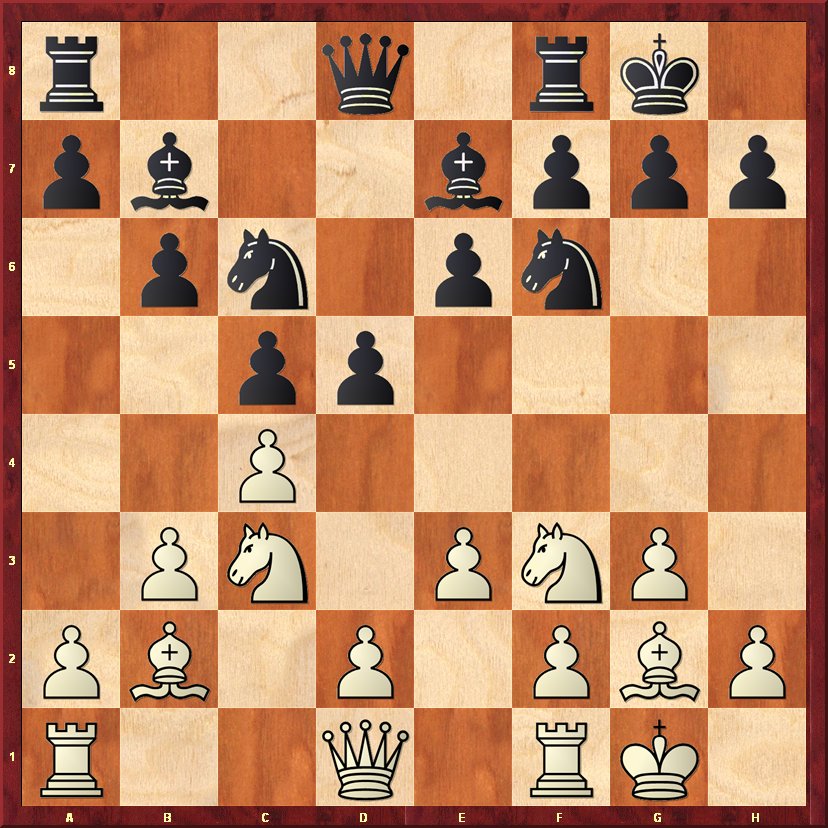
This pretty much the starting position for the whole variation. However, despite being roughly equal, 9…Nbd7 was slightly easier to play.
10.cxd5 Nxd5 11.Nxd5 Qxd5 12.d4 Rad8 13.Ne5 (Diagram 2)
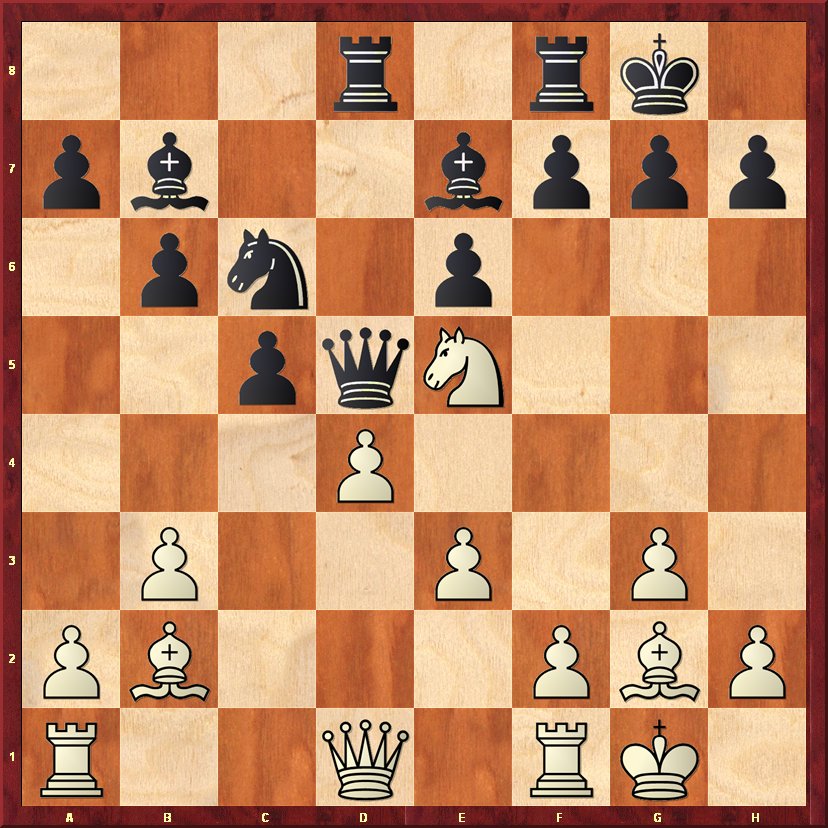
The past few moves have all been standard theory. However, here I slightly lose my head and played 13…Qxg2?! (13…Qd6 was slightly more sound. After 14.Qe2 Nxe5 15.Bxb7 Bf6 White is slightly better, but the position isn’t particularly anything special. Another try is 14.Nd7 Qf5 15.e4 Qg5 16.h4 Qh6 17.Bc1 g5 with an unbalanced position. (Diagram 3)
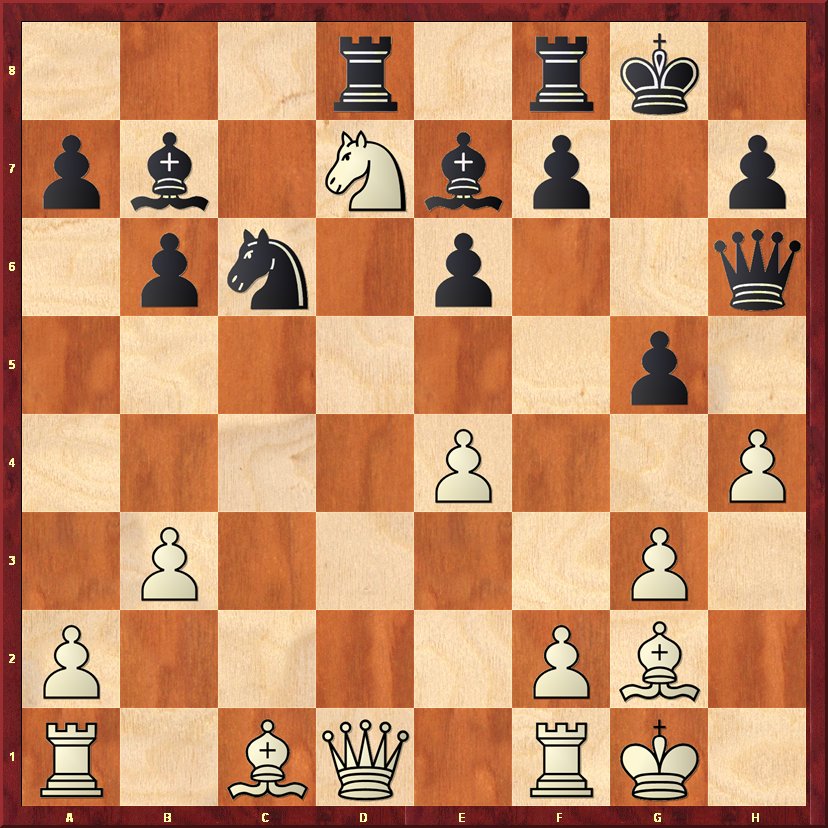
However, the game continued as follows. 14.Kxg2 Nxe5 15.f3 cxd4 16.exd4 (not 16.Bxd4 Nxf3! 17.Rxf3 e5 after which Black has no problems.) 16…Nc6 17.Qe2 Rd5 18.Rac1 Rfd8 (Diagram 4)
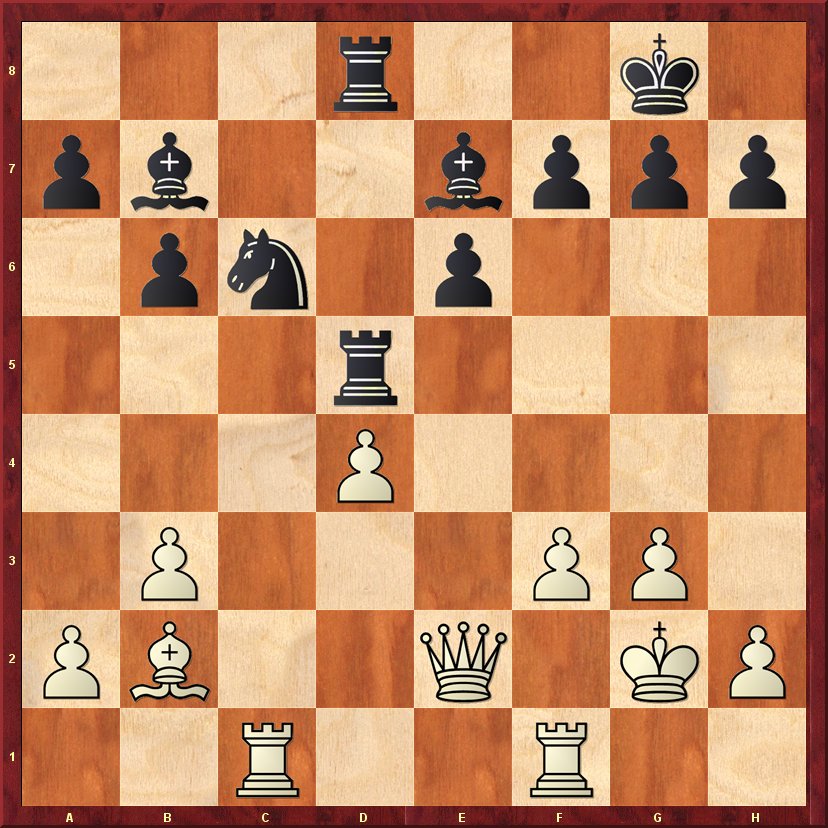
Here, I have achieved the basic setup which I envisioned when I first decided to sacrifice my queen. When I saw this position in my analysis, I simply did not see how White could progress with sacrificing an exchange somewhere. I figured that I will always have Bf6, Nxd4 ideas or even g5-g4 plans creating discoveries along the long diagonal. Unfortunately for me, Ehlvest remained calm under pressure and found the best “human” move.
19.Rc4! Ba6 (All other moves are bad. For example, 19…Bf6 20.Qf2 Nxd4 21.Rc7 Ba6 22.Rd1 and White is clearly winning. 20.Qe4 Bxc4 21. bxc4 R5d6 22.Rd1 Bf6 23.Ba3! Rxd4 24.Rxd4 Nxd4 (Diagram 5)
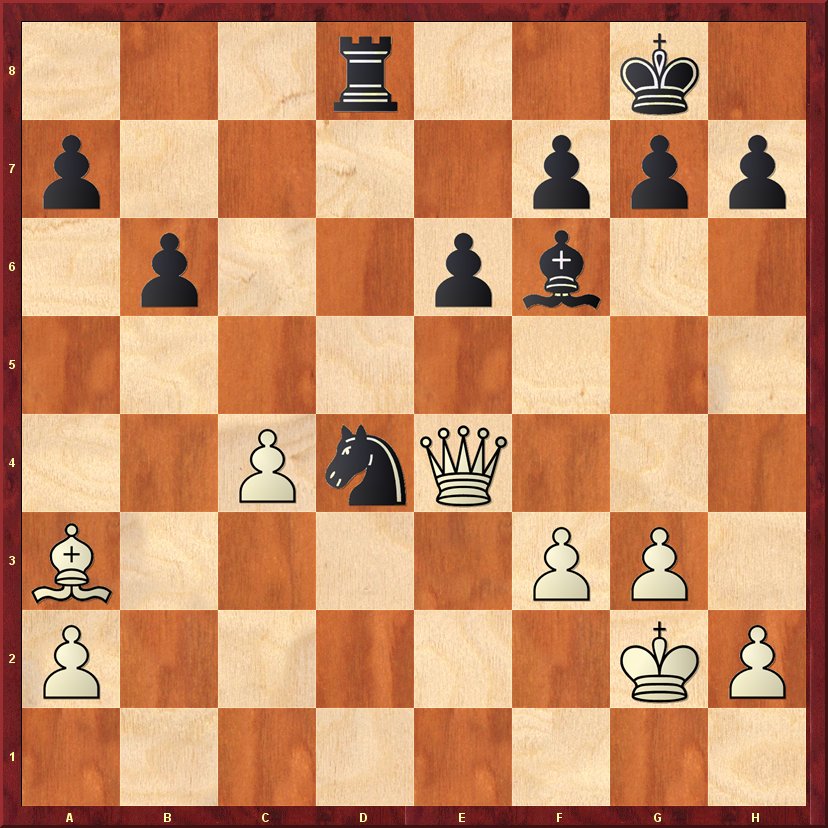
The last set of moves have been more or less forced. Ehlvest has done a good job to this point as he has simplified and retains good winning chances. 25. Bc1!? (According to the computers, 25.Qb7 g6 26.Qxa7 Nc2 27.Bc1 Ne1 28.Kh3 Nxf3 29.Qxb6 h5 30.c5! is winning. However, it is hard to blame a human as this looks quite dangerous due to g5-g4 Rd1-g1 threats or Rd1 and Rh1 ideas too.) 25…h5 26.g4! (Now 26.Qb7 would be a lot less effective after 26…Nf5 27.Qxa7 Rd1 28.Qa3 Be7 29.Qc3 Bc5.) 26…hxg4 27.fxg4 g5 (Diagram 6)
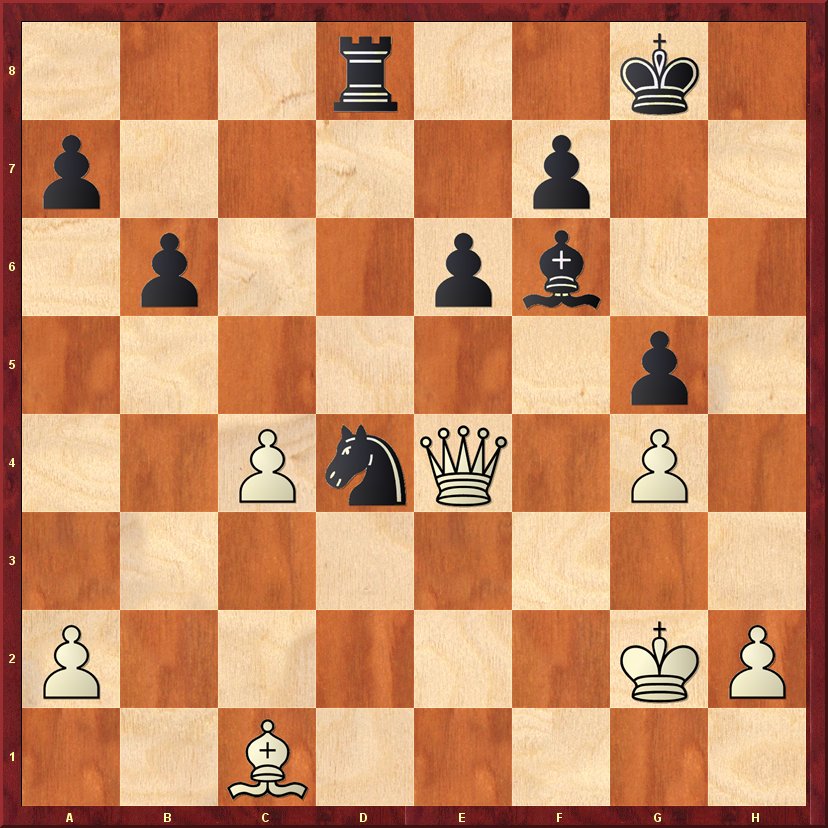
This is the critical position. If Jaan had played 28.h4! gxh4 29.Qf4! Bg7 30.Qc7 he would have had excellent winning chances. After the text move, I am able to set up a fortress more or less regardless of what he does. 28.Be3?! e5 29.a4 Rc8 30.Qd5 Ne6 31.Kf3 Be7! (Giving a pawn back, but setting up an inpenetrable fortress.) 32.Qxe5 Rxc4 33.Qb8 Kg7 34.Qxa7 Bd8 (Not 34…Bc5 35.Bxc5 Nxc5 36.Qxb6 Rf4 37.Kg3! Nxa4 38.Qd8! and Black is simply losing.) 35.Qd7 Rb4 36.h3 Bf6 37.Qd1 (Diagram 7)
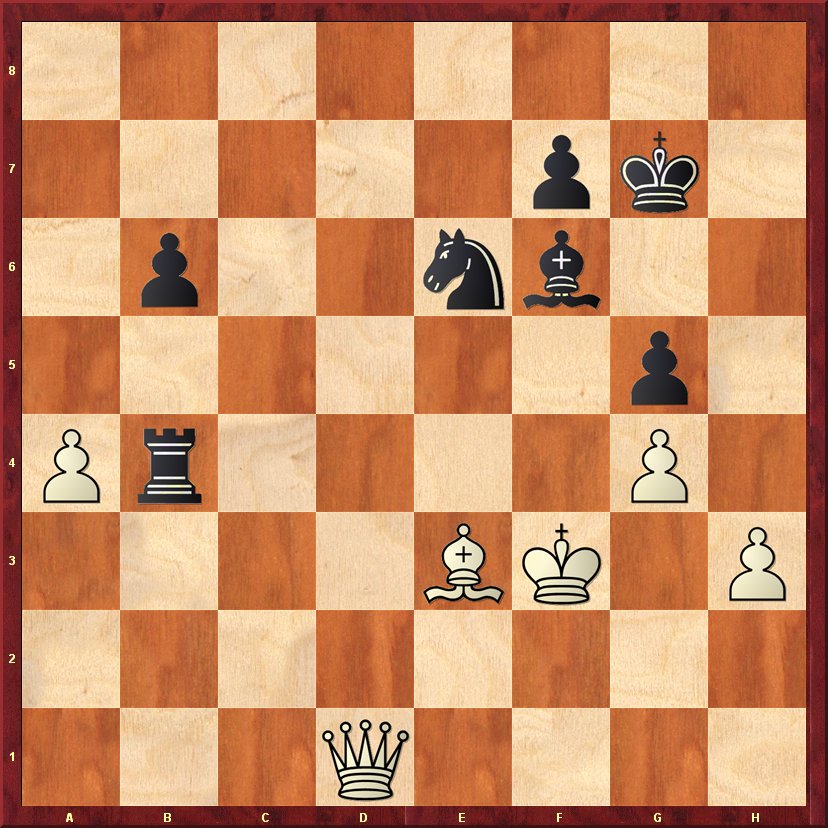
1/2-1/2
White cannot make any progress here, same as Black. Had Jaan not offered a draw, the simplest way to force a draw is 37…b5 38.axb5 (38.a5 Ra4 39.Bb6 [39.Qe1 b4=] 38…Rxb5 with complete equality.
May 22, 2009 • General
Hikaru Nakamura (2701) – Alexander Shabalov (2569), US Championship Saint Louis 8.5.2009
1.e4 c5 2.Nf3 d6 3.d4 cxd4 4.Nxd4 Nf6 5.Nc3 a6 6.Be2 e6 (Diagram 1)
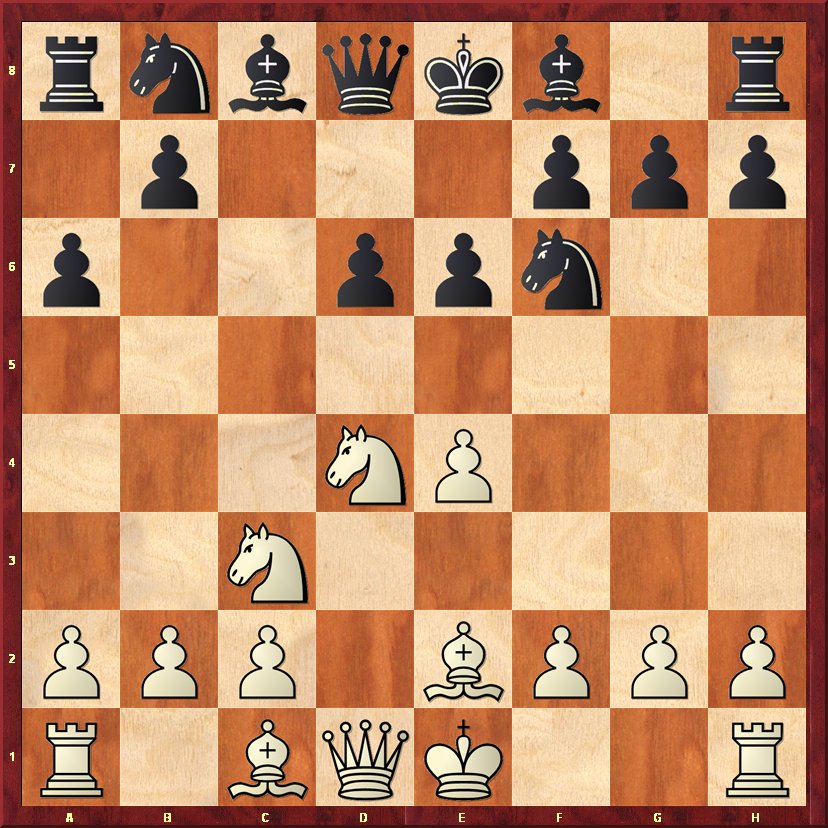
7.0-0 Be7 8.a4 0-0 9.f4 Qc7 10.Be3!? (The main line here is 10.Kh1, but I saw that Karpov had played this before, so there cannot be anything wrong it either!) 10…b6 11.Bf3 Bb7 12.f5!? (Other interesting tries are 12.g4,12.Qe1 and 12.Qe2. Each of these variations has its own flavour to it, but to put it simply it is a matter of taste. 12…e5 13.Nb3 Nbd7 14.g4!? (14.Qe2 was tried by Anand rather unsuccessfully in the game Anand–Wojtkiewicz, GMA Baleares Open 1989 and continued 14…Rfe8 15.Rfd1 Rac8 16.Nd2 Nc5 17.Bf2 d5! 18.exd5 e4 19.Bxe4 Bd6 20.Qf3 Bxh2 with a very complicated middlegame.) 14…h6 15.h4 d5!? (Diagram 2)
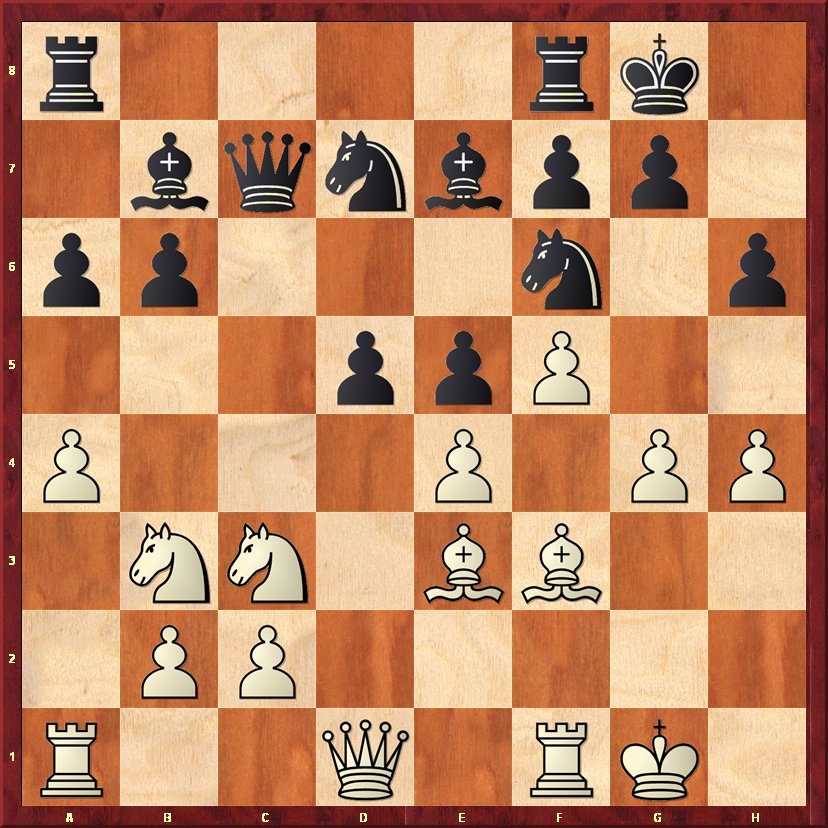
16.exd5 e4 17.Bg2 Qg3 18.Qe1N (Previously, 18.Bf2 Qxg4 19.Nxe4! Qf4 20.Bg3 Qe3 21.Kh2 Nxe4 22.Rf3 was winning in Browne-Winslow, New York Open 1986. However, when I saw 18.Bf2 over the board, I did not see a clear solution to the potential problems posed after 18…Qe5.) 18…Qxe1 (18…Qxg4 19.Rf4 Qh5 20.Nxe4 and Black is going to have some queen issues very shortly.) 19.Rfxe1 Nxg4 20.Bxb6! (Diagram 3)
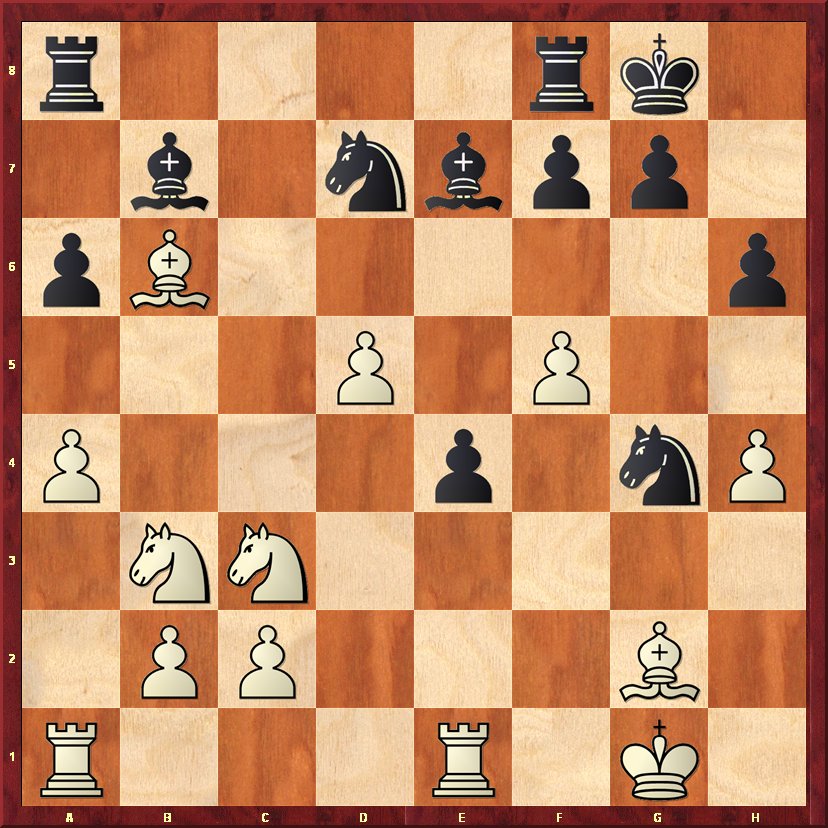
20…Nxb6 21.Rxe4 Nxd5! (During the game I simply thought this position was close to winning. Other variations such as 21….Bf6 22.Rxg4 Bxc3 23.bxc3 Bxd5 24.a5 and 21…Bf6 22.Rxe4 Rac8 23.Rb4 both are clearly winning.) 22.Nxd5 Bxd5 23.Rxe7 (23.Rxg4 Bxg2 24.Kxg2 Rab8 is roughly equal due to the lack of coordination of White’s pieces.) 23…Rfd8?! Although Rybka says this is best, I used a lot of time before playing 23.Rxe7 because I was not 100% convinced that the variation after 23…Bxg2 24.Kxg2 Rfd8 25.Kf3 h5 was that clear, especially for a human.) 24.Bf1! (Diagram 4)
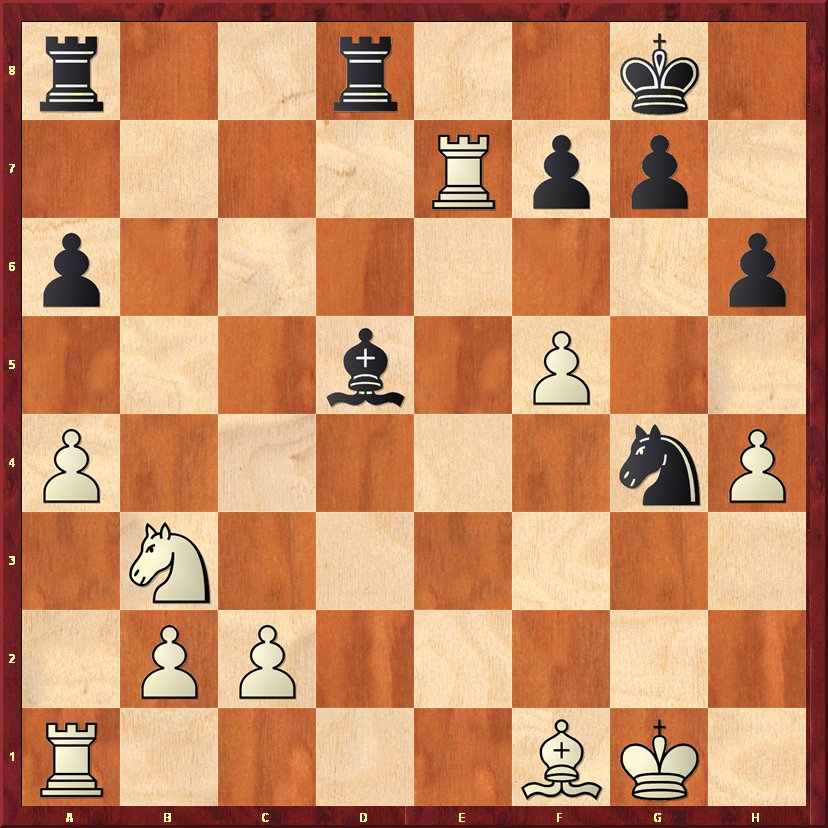
24…Kf8 25.Ree1?! (25.Rae1 was better despite allowing 25…Be6. As 26.Rc7 Bxf5 27.Ree7 Bg6 (27…Be6 28.Nc5) 28.Bd3 and White has a significant advantage.) 25…Rdb8 26.Ra3 Nf6 27.Rd1 Ra7 28.Rd2 Be4 29.Rf2 (Diagram 5)
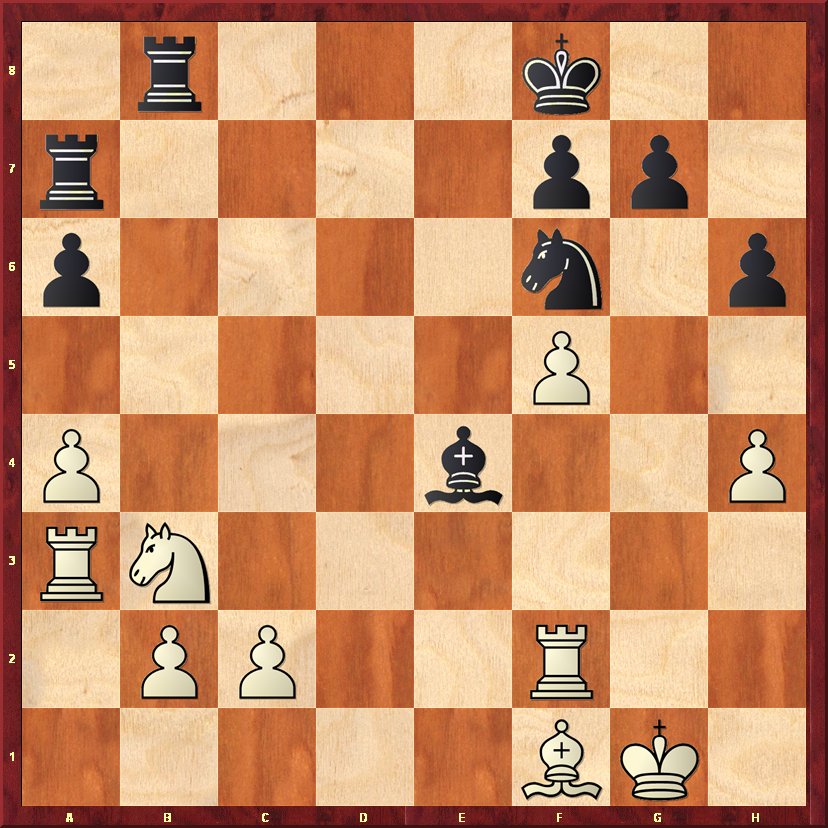
At this point in the game, I had about 3 minutes for 12 moves, while Alex had 2 minutes. If he had chosen either 29…Bd5 or 29…Ba8, it would have been really hard for me to come up with a plan to untangle my queenside in the time scramble. Fortunately for me, he panicked and blundered badly here with 29…Ng4?? 30.Rf4 Nf6 31.Nc5! Bxc2 (31…Bd5 would probably have given Alex more of a chance to survive, but the prospects are still quite bleak after 32.b4.) 32.Rf2! This was obviously the move Alex missed when he went for the whole variation. After this very nice move, Black is probably just losing. 32…Bd1 33.Nxa6 Rb6 34.b4! (Diagram 6)
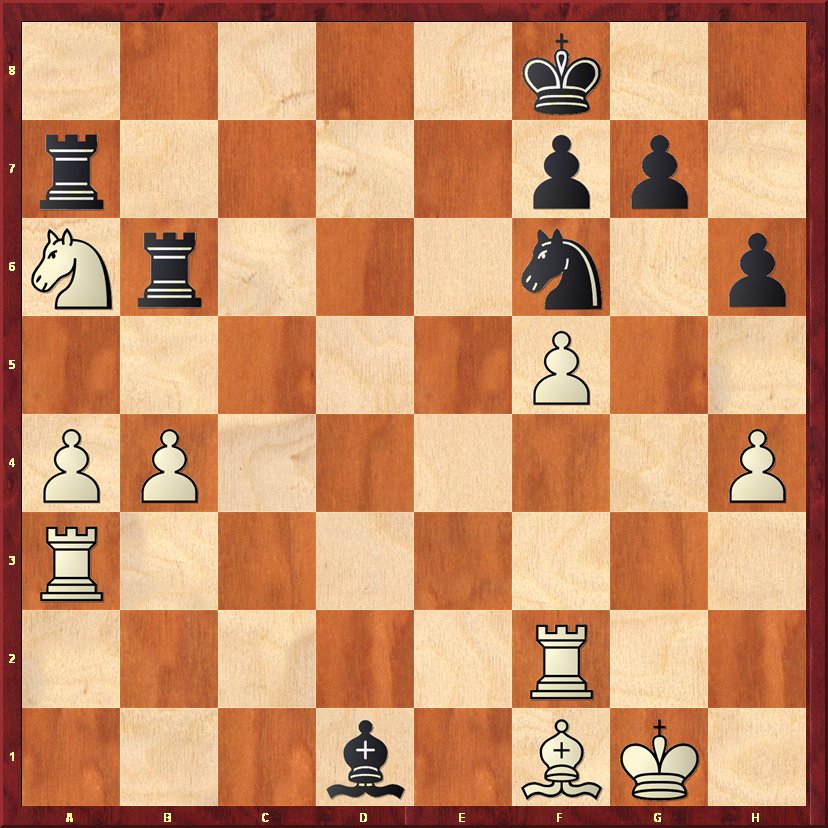
34…Rbxa6 35.Bxa6 Rxa6 36.a5 Go pawns, go! 36…Ne4 37.b5 Rd6 38.a6 Nxf2 39.a7 Nh3 40.Rxh3 (Diagram 7)
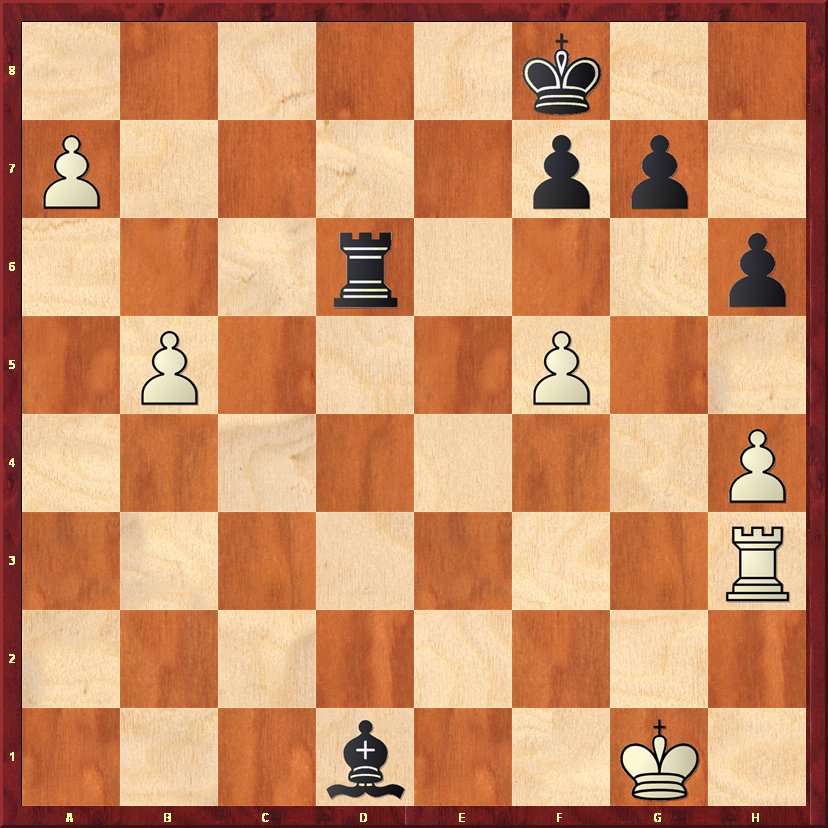
1-0 Alex resigned here in view of 40…Rd8 41.b6 followed by the inevitable 42.b7.
May 22, 2009 • General
Good morning to everyone from nice sunny and hot White Plains, New York. I apologize to everyone that I was not able to blog yesterday, but I spent much of the afternoon and evening in New York City, and I completely crashed when I got home around 10 PM from exhaustion.
In this, the third and final installment of my experiences from the US Championship, I will recap the rest of the tournament from after I won round 9 to the closing ceremony. In the last blog, I left off after I won my game against GM Josh Friedel. Throughout this game, I had my eye on the Hess-Akobian game for obvious reasons. Unlike two of his other games in the tournament, I was pleased to see that Varuzhan found a way to avoid a losing position after 15 moves with Black for a change. I was especially optimistic about the game when I saw queens come off early as this would appear to very much play to his style. At the same time, it also meant that he’d avoid getting blown off the board like he did against Gata and me.
After my game finished, I went downstairs to the commentary room and gave a few comments relatively brief comments to Emil Sutovsky,Jennifer Shahade and Macauley Peterson. I do not know if the audio broadcast was archived or not, but it was hard for me to really be anything but slightly dazed due to the incredibly anti-climatic nature of the final game I played. In 2005 when I won, I had to grind a very complicated endgame against GM Ildar Ibragimov which went well into the fifth hour. This time around, with a short three hour game requiring very little effort it was hard to say much of anything. After I left the commentary room, I went outside and made a brief call to my parents before Kris&I went off to get some lunch at Culpepper’s. About five or six minutes after we ordered food, I got several messages from people on my crackberry hearing that the game Hess-Akobian was drawn. In retrospect, I’m a little surprised I didn’t start screaming at the top of my lungs considering how much this victory meant to me. After I gulfed down my food, I ran back to the club for the final interview which I believe is on the actual website of the Saint Louis Chess Club.
Kris and I headed back to our hotel briefly just to see Kobe and company dominate the Rockets completely in game seven. After this we just chilled out and kicked back having accomplished our goal. I also tried to work on a speech while getting numerous messages and emails, etc from people. However, this proved to be a futile exercise as I just simply could not focus due to the massive amount of communication. Thank you for turning my life upside down, research in motion! After this, we headed back to the site hotel, The Chase Park Plaza for the ceremony while putting down our windows and blasting the brilliant song Last of Wilds. I have to say that not having a care in the world and being on such an emotional high is really what competition is all about.
The closing ceremony itself was held on the top floor of the ritzy Chase Park Plaza, although I forgot the name of the exact room and rooftop patio. Overall, it was very well done with alcohol (what a surprise) and plenty of h’orderves. When I first got up there, I had a feeling I’d get more than simply the big check like I had before and my intuition proved to be correct as they had a special jacket for the winner. There were many speeches including mine which were fun to listen to, although my speech got completely thrown off when my father inadvertently called me while I was actually talking. I must say that it is very hard to maintain your train of thought when you have a blackberry in your pocket vibrating. However, I somehow stumbled and bumbled through it and seemed to do a good enough job, so I won’t complain. After this we were treated to opera singing from Emil Sutovsky which, although, is not my type of music was nevertheless quite good. There really is nothing more to report after this other than accepting numerous congratulations enjoying myself and just realizing what a true pleasure it is to be at a chess tournament where every participant was treated as though chess is a sport and something worth being recognized. So with that, I bring to a close my report on the US Championship. It was a truly phenomenal event and probably the smoothest, stress free event which I have had the fortune to participate in.
















